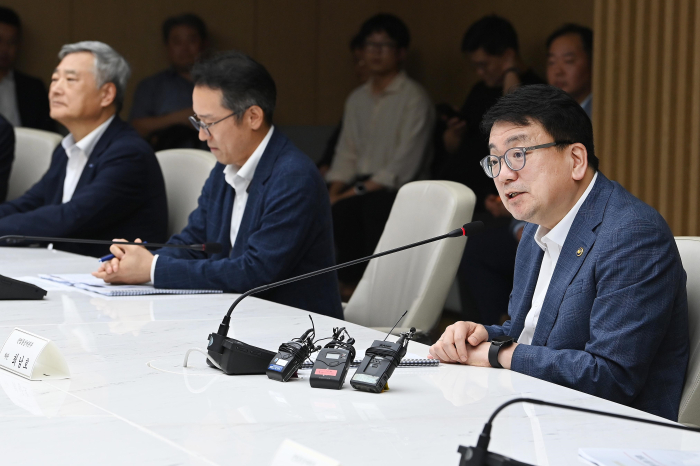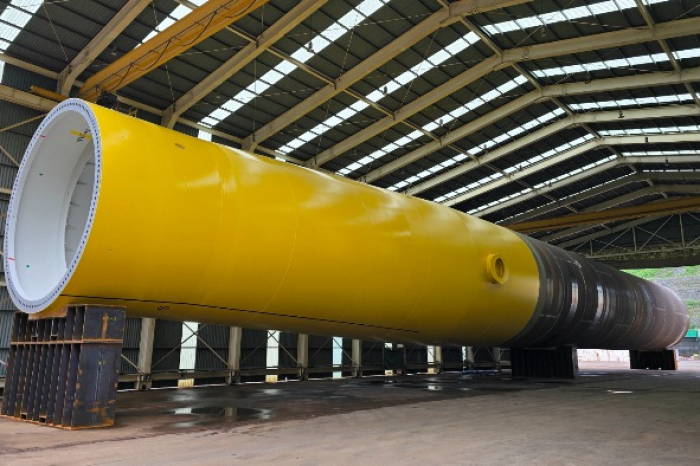Korea seeks to curb China's offshore wind farm dominance
In 2023, South Korea's offshore wind power project was awarded to five foreign companies, including some Chinese firms
By Aug 09, 2024 (Gmt+09:00)
LG Chem to sell water filter business to Glenwood PE for $692 million


KT&G eyes overseas M&A after rejecting activist fund's offer


Kyobo Life poised to buy Japan’s SBI Group-owned savings bank


StockX in merger talks with Naver’s online reseller Kream


Meritz backs half of ex-manager’s $210 mn hedge fund



South Korea will prioritize non-price factors such as economic security and contributions to the domestic supply chain over bidding prices when selecting operators and suppliers for offshore wind power projects, the Ministry of Trade, Industry and Energy (MOTIE) said on Thursday.
The move is aimed at containing the influence of China in the country’s burgeoning wind power industry, into which South Korea is expected to inject about 50 trillion won ($36 million) over the next two years.
Under the revised competitive bidding roadmap for domestic offshore wind farms, South Korea will screen out bidders based on non-price factors in the first evaluation process, which makes up 50% of the components of bid assessments, higher than the previous 40%.
Then it will compare bidding prices in the second-round assessment.
In addition to the impact on economic security and contributions to the domestic supply chain, non-economic factors include the public sector’s participation in the projects; meeting the construction schedule; offering timely maintenance services; and whether or not to have a local unit.
The weighting of national security and the public sector’s participation was lifted to 26% from 16% under the revised roadmap.
The new criteria will apply from the tender for the 1.5-2 gigawatts (GW) offshore wind power project due in October.
“Our offshore wind power projects are large in scale, but domestic technological prowess in key equipment has not yet reached that of leading countries, so much of it needs to be done with overseas companies,” said a MOTIE official.
“Through this measure, we may able to restrict the entry of foreign companies or products that could threaten our national security,” he noted.

Despite offering lower prices than other bidders, if they use major components and equipment imported from foreign countries, they could be eliminated from the competition, according to the MOTIE.
50 TRILLION WON IN PROJECTS
In the announcement of the revised roadmap held at the Korea Chamber of Commerce and Industry, the MOTIE said the government will launch 7-8 gigawatt (GW) offshore wind power tenders over the next two years.
The 7-8GW wind power capacity is equivalent to the electricity generated by eight nuclear reactors.
The projects will be divided into one for 3-3.5GW in 2025 and one for 2-3GW in 2026, in addition to the 1.5-2GW project to be awarded later this year.
Considering that a one-gigawatt wind farm costs about 7 trillion won, the projects are estimated at about 50 trillion won ($36 billion) in aggregate.
MOTIE forecast South Korea will have a combined 18.3GW wind power capacity by 2030.
FOREIGN FIRMS THAT TEAM UP WITH KOREAN UTILITIES
In the October auction, foreign companies that team up with domestic power utilities will be preferred over other foreign firms, according to the ministry.

Last year, South Korea awarded the 1.4GW offshore wind farm project to five foreign companies, including Denmark’s Vestas and China’s Mingyang. Some of the winners offered sharply low prices, taking advantage of cheap Chinese equipment.
NATIONAL SECURITY RISKS
The auction results stirred concerns among Korean wind energy industry watchers.
Wind power generators made in other countries could be shut down by remote control abroad, exposing them to national security risks such as cyberattacks. The absence of their local operations could delay maintenance and repair services.
Some experts warn that in the process of building infrastructure to transfer electricity produced by offshore wind farms to land, information on the topography of the domestic seabed may be leaked to hostile countries.
In the first half of next year, the country will establish a new bidding market restricted to domestic companies, in which state-run power companies have a 70% stake or more.
Further, from next year South Korea will advance the timing of competitive bidding for offshore wind farms from the fourth quarter to the second quarter of the year.
Write to Jung-Hwan Hwang at jung@hankyung.com
Yeonhee Kim edited this article
-
 EnergySamsung signs wind turbine structure supply deal with Equinor
EnergySamsung signs wind turbine structure supply deal with EquinorAug 07, 2024 (Gmt+09:00)
1 Min read -
 EnergyS. Korea may join offshore wind alliance to take on China
EnergyS. Korea may join offshore wind alliance to take on ChinaJul 08, 2024 (Gmt+09:00)
4 Min read -
 EnergyGrowing controversy over call to share profits for using wind energy
EnergyGrowing controversy over call to share profits for using wind energyApr 16, 2024 (Gmt+09:00)
4 Min read -
 Shipping & ShipbuildingHD Hyundai, Scottish firms to cooperate on offshore wind power
Shipping & ShipbuildingHD Hyundai, Scottish firms to cooperate on offshore wind powerApr 17, 2024 (Gmt+09:00)
1 Min read -
 EnergyOrsted wins 1.6 GW offshore wind power license from Korea
EnergyOrsted wins 1.6 GW offshore wind power license from KoreaDec 01, 2023 (Gmt+09:00)
2 Min read -
 EnergyPOSCO Int'l, Equinor tie up for Ulsan offshore wind project
EnergyPOSCO Int'l, Equinor tie up for Ulsan offshore wind projectSep 08, 2023 (Gmt+09:00)
1 Min read -
 EnergyHyundai Engineering to produce offshore wind power on Chuja Islands
EnergyHyundai Engineering to produce offshore wind power on Chuja IslandsSep 01, 2023 (Gmt+09:00)
1 Min read -
 EnergyPOSCO E&C to build offshore wind power plant with Norwegian firm
EnergyPOSCO E&C to build offshore wind power plant with Norwegian firmAug 25, 2023 (Gmt+09:00)
1 Min read -
 EnergyGS Entec signs deal with global offshore wind power developer
EnergyGS Entec signs deal with global offshore wind power developerJul 25, 2023 (Gmt+09:00)
1 Min read -

-
 Shipping & ShipbuildingS.Korea launches its first offshore wind installation vessel
Shipping & ShipbuildingS.Korea launches its first offshore wind installation vesselJun 13, 2023 (Gmt+09:00)
1 Min read -
 EnergyLS Cable, Hanwha to build S.Korea’s largest offshore wind farm
EnergyLS Cable, Hanwha to build S.Korea’s largest offshore wind farmJun 07, 2023 (Gmt+09:00)
1 Min read -
 EnergyDoosan Enerbility, Siemens Gamesa join forces for offshore wind power
EnergyDoosan Enerbility, Siemens Gamesa join forces for offshore wind powerFeb 07, 2023 (Gmt+09:00)
1 Min read -
 Corporate investmentDanish wind turbine firm Vestas to invest $300 million in Korea
Corporate investmentDanish wind turbine firm Vestas to invest $300 million in KoreaJan 19, 2023 (Gmt+09:00)
2 Min read


